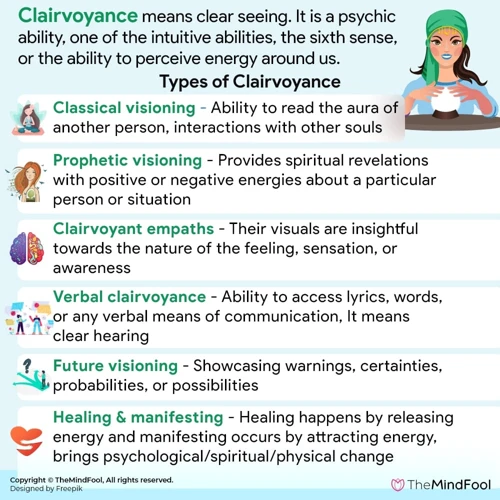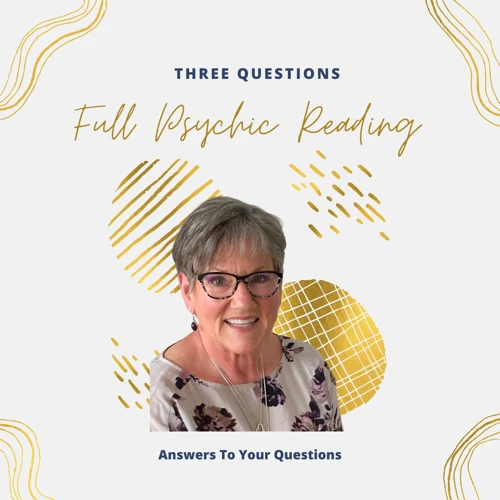Welcome to the fascinating world of clairvoyant visions. In this article, we will explore the different types of clairvoyant visions and delve into how clairvoyants receive and interpret these visions. Clairvoyance, often referred to as the “sixth sense,” is the ability to perceive or obtain information about objects, people, or events through extrasensory perception. It is a phenomenon that has intrigued and captivated people for centuries. So, get ready to expand your knowledge and delve into the mystical realm of clairvoyant visions!
Contents
- What is Clairvoyance?
- Types of Clairvoyant Visions
- How Clairvoyants Receive Visions
- Interpreting Clairvoyant Visions
- Developing Clairvoyant Abilities
- Understanding the Limitations of Clairvoyance
- Conclusion
-
Frequently Asked Questions
- What are some common misconceptions about clairvoyance?
- Can anyone develop clairvoyant abilities?
- What is the role of meditation in developing clairvoyance?
- How do clairvoyants receive their visions?
- Are clairvoyant visions always clear and easy to interpret?
- What is the difference between clairvoyance and remote viewing?
- Can clairvoyance be used to connect with the spiritual realm?
- Is clairvoyance a rare ability?
- Can clairvoyant visions change or be influenced by external factors?
- Is clairvoyance scientifically proven?
- References
What is Clairvoyance?

Clairvoyance is a psychic ability that allows individuals to perceive information about objects, people, or events through extrasensory perception. It is often considered a form of sixth sense, as it goes beyond the limitations of the five physical senses. People with this ability, known as clairvoyants or seers, are able to receive visions or images that are not visible to others. These visions can provide insight into past, present, or future events, and can occur spontaneously or be triggered by specific techniques or practices.
One common misconception about clairvoyance is that it is the same as fortune-telling or predicting the future. While clairvoyants may have the ability to see future events, clairvoyance is not solely limited to predicting the future. It can also involve perceiving information about the past or gaining insights into present situations. Additionally, clairvoyant visions can vary in their clarity and symbolism, requiring interpretation to fully understand their meaning.
To enhance their clairvoyant abilities, many practitioners use visualization techniques. These techniques involve mentally creating images and scenarios to stimulate the clairvoyant senses. By visualizing specific scenes or objects, individuals can train and strengthen their clairvoyant abilities, allowing them to access information beyond their normal perception. Meditation is also of great importance in developing clairvoyance. Regular meditation practices help to quiet the mind and enhance focus, allowing individuals to tap into their intuitive abilities more easily.
Types of Clairvoyant Visions

Clairvoyant visions can take various forms, each offering unique insights and perceptions. One type of clairvoyant vision is precognition, which involves the ability to see future events before they occur. This can be experienced as vivid dreams, flashes of images, or a strong sense of knowing. Another type is remote viewing, where clairvoyants are able to see and describe events or locations that are physically distant from them. Aura reading is another fascinating ability, where clairvoyants can see and interpret the energy fields surrounding individuals, gaining information about their emotions, health, and spiritual state. Psychometry, on the other hand, involves receiving visions or impressions by touching objects or connecting with their energy. Lastly, symbolic visions, such as seeing signs, symbols, or archetypes, can hold deep meaning and insights for clairvoyants. These different types of visions provide a diverse range of information and experiences for clairvoyants to explore and interpret.
Precognition
Precognition is a fascinating aspect of clairvoyant visions that involves the ability to perceive events or information about the future. Those with precognitive abilities are able to gain insight into upcoming events, allowing them to anticipate or prepare for what is to come. These visions can appear in various forms, such as flashes of images, dreams, or strong intuitive feelings.
Precognition is often misunderstood and associated with fortune-telling or the ability to predict specific details of future events. However, it is important to note that precognitive visions are often symbolic and open to interpretation. They may provide a general sense of what is to come rather than precise details. It is also crucial to remember that the future is not set in stone and can be influenced by various factors, including individuals’ choices and actions.
To enhance the precognitive abilities of clairvoyants, visualization techniques can be utilized. By picturing themselves in future scenarios or envisioning specific events, individuals can strengthen their connection to the realm of precognition. Meditation is also beneficial in developing this ability, as it helps quiet the mind and allows individuals to tap into their intuitive senses more effectively.
Remote Viewing
Remote viewing is a form of clairvoyant vision where individuals are able to perceive people, places, or events that are geographically distant from their physical location. It is often used in the field of parapsychology and has been the subject of scientific research. The process of remote viewing involves the practitioner entering a deep state of relaxation or meditation and then focusing their attention on the target they want to perceive. This target can be a specific location, an object, or even a person.
During a remote viewing session, the individual may receive impressions, images, or even sensory information about the target. These impressions can include visual images, sounds, smells, tastes, or even physical sensations. It is important to note that remote viewing is not the same as astral projection or out-of-body experiences, as the practitioner remains in their physical body while perceiving the remote target.
Remote viewing has been used for various purposes, including espionage, archaeological discoveries, and even locating missing persons. It is believed that by accessing information outside the limits of physical space, remote viewers can gather valuable insights that may not be accessible through conventional means. It is a fascinating area of clairvoyant vision that continues to be explored and studied.
Aura Reading
Aura reading is a type of clairvoyant vision that involves perceiving and interpreting the energy fields that surround individuals, known as auras. Auras are believed to be subtle electromagnetic fields that emanate from living beings and contain information about their physical, emotional, and spiritual states. With the ability to see auras, clairvoyants can gain insights into a person’s energy, personality traits, and even their overall well-being.
During an aura reading, a clairvoyant may perceive the colors, patterns, and intensity of the aura surrounding an individual. Each color in the aura is associated with different qualities and emotions. For example, a bright and vibrant aura may indicate vitality and positivity, while a dull or murky aura may suggest exhaustion or negative emotions.
It’s important to note that aura reading is often misunderstood. Some people mistakenly believe that auras can reveal specific details about a person’s future or past lives, but this is a common misconception. Aura reading primarily provides insights into an individual’s present state, their energy levels, and the overall balance of their being.
To develop the ability to read auras, clairvoyants often practice visualization techniques, such as imagining themselves surrounded by light or visualizing colors and energy radiating from people. These exercises help to strengthen their intuitive perception and enhance their ability to see and interpret auras more clearly.
Psychometry
Psychometry is a fascinating type of clairvoyant vision where individuals can gather information or impressions about a person or an object by touching or holding it. It is believed that every object absorbs the energy or vibrations of its owner or its surroundings, and psychometry allows clairvoyants to tap into that energy and gain insights. When a clairvoyant holds an item, they may receive vivid images, emotions, or even past experiences associated with the object or its owner.
During a psychometry session, the clairvoyant focuses their attention on the object, allowing their senses to connect with its energetic imprint. The information received can vary from person to person depending on their clairvoyant abilities. Some may see symbols or visuals related to the owner’s experiences, while others may feel intense emotions or physical sensations associated with the object.
Psychometry can be a useful tool in various situations. For example, in a missing person case, a clairvoyant may use psychometry to hold an article of clothing belonging to the missing person, which could provide valuable insights into their whereabouts or state of being. Similarly, when working with historical artifacts, psychometry can offer glimpses into the past and provide a deeper understanding of the object’s significance.
To develop and enhance psychometric abilities, clairvoyants can practice visualization techniques to strengthen their connection with objects and their energetic imprints. They can also incorporate meditation into their daily routine to improve focus and clarity of perception. By honing their psychometric skills, clairvoyants can unlock a whole new level of insight and understanding.
If you’re interested in learning more about enhancing clairvoyant abilities through visualization techniques, check out our previous article on enhancing clairvoyant abilities through visualization techniques. For those looking to develop clairvoyance, meditation plays a vital role. You can find more information about the importance of meditation in developing clairvoyance in our article on the importance of meditation in developing clairvoyance.
Symbolic Visions
- Symbolic visions are a common form of clairvoyant experience, where images or symbols are presented to the clairvoyant
- These symbols often carry deeper meanings that need to be interpreted to fully understand their significance
- Each symbol may represent something specific, such as an emotion, a situation, a person, or a potential outcome
- Clairvoyants may see symbols in their mind’s eye or as if projected onto their physical surroundings
- The interpretation of symbolic visions requires the clairvoyant to rely on their intuition and personal understanding of symbols
- It is important to note that symbolic visions can vary from person to person, as different symbols may hold different meanings for each individual
- Understanding and decoding the symbolism in clairvoyant visions can often provide valuable insights and guidance
How Clairvoyants Receive Visions

- Sensory Impressions: One way that clairvoyants receive visions is through sensory impressions. They may experience vivid images, colors, or scenes that appear in their mind’s eye. These impressions can feel as real and tangible as actual sensory experiences, allowing the clairvoyant to gather information about the subject of their vision.
- Psychic Intuition: Another way that clairvoyants receive visions is through psychic intuition. This is a deep knowing or understanding that goes beyond logical reasoning. Clairvoyants may receive flashes of insight or sudden understandings about a person, situation, or event. These intuitive impressions can provide valuable information and guidance.
- Symbolic Language: Visions received by clairvoyants often come in the form of symbols or metaphors. The symbols may have personal or universal meanings, and it is up to the clairvoyant to interpret their significance. For example, seeing a butterfly in a vision could represent transformation or a new beginning.
- Divination Tools: Some clairvoyants use divination tools, such as tarot cards or crystal balls, to aid in receiving visions. These tools act as a focal point or conduit for their psychic abilities, helping them to access information beyond their normal perception.
- Spiritual Guidance: Many clairvoyants believe that they receive visions through the guidance of spiritual entities or their higher self. They may connect with their spirit guides or tap into the collective consciousness to obtain the information they seek.
Interpreting Clairvoyant Visions

Interpreting clairvoyant visions is a crucial aspect of harnessing this psychic ability. When receiving a clairvoyant vision, it is important to pay attention to the symbols and imagery presented. Symbols can hold various meanings, and understanding their significance can provide valuable insights. These symbols can be personal, cultural, or archetypal and may require some reflection and analysis. In addition to symbols, clairvoyant visions can evoke emotional and sensory impressions. Paying attention to the feelings, sensations, and emotions that arise during these visions can offer further clues about their meaning. Trusting one’s intuition, or intuitive knowing, is also essential in interpreting clairvoyant visions. This intuitive sense allows individuals to tap into their inner wisdom and gain a deeper understanding of the messages conveyed through the visions. By combining the analysis of symbols, emotional and sensory impressions, and intuitive knowing, individuals can begin to interpret and make sense of their clairvoyant visions.
Symbols and Imagery
Symbols and Imagery:
Symbols and imagery play a crucial role in the interpretation of clairvoyant visions. When receiving a vision, clairvoyants often see symbols or images that carry deeper meanings. These symbols can be universal, such as seeing a snake representing transformation or a butterfly representing growth and change. They can also be personal, unique to the individual receiving the vision. For example, a clairvoyant may see a specific flower that holds significance to them personally, representing love or healing.
Interpreting these symbols requires a deep understanding of their context and personal significance. Symbolism is subjective, and different symbols can hold different meanings for each individual. The interpretation of symbols often relies on the clairvoyant’s intuition and knowledge of personal symbolism and cultural associations.
Imagery is another important aspect of clairvoyant visions. The images that clairvoyants see can range from vivid and detailed scenes to abstract or fragmented visuals. These images can be literal representations of events or can be metaphorical, representing emotions, energies, or spiritual concepts.
To interpret symbols and imagery within clairvoyant visions, clairvoyants often rely on their intuitive abilities and experience in working with visions. They observe the details of the symbols and images, paying attention to colors, shapes, and patterns. They may also consider any emotions or sensations associated with the vision, as these can provide additional insights into its meaning.
Emotional and Sensory Impressions
Emotional and sensory impressions play a vital role in the interpretation of clairvoyant visions. When receiving a vision, clairvoyants not only see images but also experience a range of emotions and physical sensations. These impressions can provide important clues and insights into the meaning of the vision.
Emotional impressions involve feeling the emotions associated with the vision. For example, when receiving a vision of a person, a clairvoyant may also experience the emotions that the person is feeling or has felt in the past. These emotions can include joy, sadness, fear, or anger, among others. The emotional impressions act as a way for clairvoyants to connect with the energy and essence of the vision.
Sensory impressions, on the other hand, involve perceiving physical sensations related to the vision. This can include feeling temperature changes, tingling sensations, or even pain in certain areas of the body. For instance, if a clairvoyant receives a vision of a car accident, they may feel a jolt or impact sensation in a particular part of their body, indicating the location of the impact in the accident.
Combining emotional and sensory impressions with the visual aspects of a clairvoyant vision allows for a more comprehensive understanding of its meaning. These impressions provide additional layers of information that can help decipher the message or significance behind the vision.
Intuitive Knowing
Intuitive knowing is a powerful aspect of interpreting clairvoyant visions. Unlike symbols and imagery, which require interpretation and analysis, intuitive knowing is a direct and immediate understanding of the meaning behind a clairvoyant vision. It is a deep sense of knowing that goes beyond logical reasoning or conscious thought.
When a clairvoyant experiences intuitive knowing, they simply “know” what the vision represents or what message it is conveying. This can manifest as a strong feeling, a gut instinct, or a profound sense of certainty. It is as if the information is being downloaded directly into their consciousness.
Intuitive knowing can be likened to a hunch or a flash of insight. It is a form of instant understanding that is not based on logical analysis or external evidence. It is important for clairvoyants to trust and follow their intuitive knowing, as it often holds valuable insights and guidance.
To better understand intuitive knowing, let’s consider an example. Imagine a clairvoyant has a vision of a broken clock. Without any logical reasoning, they immediately know that this symbolizes the end of a particular phase or cycle in someone’s life. This intuitive knowing bypasses the need for the clairvoyant to dissect the symbolism of a broken clock or rely on external sources for validation.
Intuitive knowing is a profound and direct understanding of the meaning behind clairvoyant visions. It is a valuable tool that allows clairvoyants to quickly grasp the significance of their visions and provide meaningful insights and guidance.
Developing Clairvoyant Abilities

Developing clairvoyant abilities is a journey that requires dedication, practice, and an open mind. While some individuals may have a natural inclination towards clairvoyance, everyone has the potential to tap into this psychic ability. One of the key aspects of developing clairvoyance is honing one’s intuitive senses and connecting with one’s higher self.
Visualization techniques are commonly used to enhance clairvoyant abilities. By visualizing specific scenes, objects, or scenarios, individuals can strengthen their ability to receive and interpret clairvoyant visions. This can be done through guided meditations, where individuals are led through visualizations that stimulate their clairvoyant senses.
Another effective practice for developing clairvoyance is maintaining a dream journal. Dreams are a natural avenue for receiving clairvoyant visions, as the subconscious mind is more active during sleep. By keeping a journal and recording dreams, individuals can identify patterns, symbols, and themes that may provide insight into their clairvoyant abilities.
Regular meditation is also crucial in the development of clairvoyance. Meditation helps to quiet the mind, increase focus, and create a state of receptivity to clairvoyant information. By setting aside dedicated time for meditation, individuals can create a conducive environment for their clairvoyant abilities to flourish.
It is worth noting that developing clairvoyant abilities takes time and patience. It is important to approach the journey with an open mind and without putting pressure on oneself to achieve immediate results. Embracing a mindset of curiosity and self-discovery can greatly enhance the development of clairvoyant abilities.
Understanding the Limitations of Clairvoyance
While clairvoyance is a remarkable ability, it is important to understand its limitations. One key limitation is that clairvoyant visions are not always clear-cut or literal. The information received through clairvoyance is often symbolic and requires interpretation. This symbolism can be influenced by personal biases, experiences, and cultural references, which may affect the accuracy of the interpretation.
Another limitation of clairvoyance is that it is not always reliable or consistent. Not all clairvoyant visions are guaranteed to come true, as they can be influenced by external factors, free will, and the ever-changing nature of the future. It is essential to approach clairvoyant insights with an open mind and a healthy dose of skepticism, understanding that they are not infallible predictions.
Clairvoyants may not have complete control over when or how their visions occur. Visions may come spontaneously and unpredictably, making it challenging to harness this ability on demand. Additionally, the clarity and frequency of clairvoyant visions can vary from person to person, and even within an individual over time.
It is also important to note that clairvoyance is just one facet of psychic abilities and should not be seen as the only source of information or guidance. Relying solely on clairvoyant insights may limit a person’s understanding and perspective. It is wise to consider other sources of information, such as logic, intuition, and practical reasoning when making decisions or seeking guidance.
By understanding these limitations and approaching clairvoyant visions with a balanced perspective, individuals can make the most of this extraordinary ability and incorporate it into their lives in a responsible and meaningful way.
Conclusion
In conclusion, exploring the different types of clairvoyant visions offers a fascinating glimpse into the realm of extrasensory perception. Clairvoyance, as the ability to perceive information beyond the physical senses, allows individuals to access insights and knowledge that would otherwise remain hidden. Through various types of clairvoyant visions such as precognition, remote viewing, aura reading, psychometry, and symbolic visions, clairvoyants gain access to a wealth of information about past, present, and future events.
Clairvoyants receive these visions through different means, whether it be through spontaneous occurrences or specific techniques and practices. They then interpret these visions, relying on symbols, imagery, emotional impressions, and intuitive knowing to understand their deeper meanings.
Developing clairvoyant abilities requires dedication and practice. Visualization techniques and regular meditation play a crucial role in enhancing these abilities. However, it is important to understand the limitations of clairvoyance. While clairvoyant visions can provide valuable insights, they are not infallible and should be approached with an open mind and discernment.
Overall, delving into the intricacies of clairvoyant visions opens up new dimensions of perception and understanding. It invites us to expand our awareness and explore the mysteries of the unseen. So, whether you are a believer or a skeptic, the world of clairvoyance offers an intriguing exploration into the depths of human consciousness.
Frequently Asked Questions
What are some common misconceptions about clairvoyance?
A common misconception about clairvoyance is that it is synonymous with fortune-telling or predicting the future. While clairvoyants may have the ability to see future events, clairvoyance extends beyond just predicting the future. It can also involve perceiving information about the past or gaining insights into present situations.
Can anyone develop clairvoyant abilities?
Yes, clairvoyant abilities can be developed by anyone with dedication and practice. While some individuals may have a natural inclination towards clairvoyance, everyone has the potential to enhance their intuitive abilities through techniques like visualization and meditation.
What is the role of meditation in developing clairvoyance?
Meditation plays a crucial role in developing clairvoyance. Regular meditation practices help to quiet the mind, enhance focus, and increase awareness. By calming the chatter of everyday thoughts, individuals can access their intuitive abilities more easily and receive clearer clairvoyant visions.
How do clairvoyants receive their visions?
Clairvoyants receive visions through extrasensory perception, which goes beyond the limitations of the five physical senses. These visions can occur spontaneously or be triggered by specific techniques or practices such as meditation or visualization.
Are clairvoyant visions always clear and easy to interpret?
No, clairvoyant visions can vary in their clarity and symbolism. Sometimes the visions may be crystal clear, while other times they may be more abstract and require interpretation. Symbolism plays a significant role in clairvoyant visions and understanding their meaning often involves deciphering the symbols.
What is the difference between clairvoyance and remote viewing?
While both involve extrasensory perception, clairvoyance and remote viewing are different in their focus. Clairvoyance primarily pertains to perceiving information about objects, people, or events, regardless of the distance. Remote viewing, on the other hand, specifically involves perceiving or gathering information about a distant or unseen target.
Can clairvoyance be used to connect with the spiritual realm?
Yes, clairvoyance is often used by individuals to connect with the spiritual realm. It can provide insight into spiritual beings, guides, or past loved ones, allowing individuals to receive messages or guidance from the spiritual realm.
Is clairvoyance a rare ability?
While not everyone possesses clairvoyant abilities, it is not an extremely rare ability. Many individuals have varying degrees of clairvoyant potential and can develop their intuitive skills through practice and dedication.
Can clairvoyant visions change or be influenced by external factors?
Yes, clairvoyant visions can be influenced by external factors such as the energy or intentions of the practitioner, the environment, or the presence of other individuals. It is important for clairvoyants to create a focused and conducive environment to ensure clear and accurate visions.
Is clairvoyance scientifically proven?
While clairvoyance falls under the realm of paranormal phenomena, it is not widely accepted or proven by scientific methods. However, there have been numerous anecdotal accounts and experiences that suggest the existence and validity of clairvoyance as a psychic ability.







